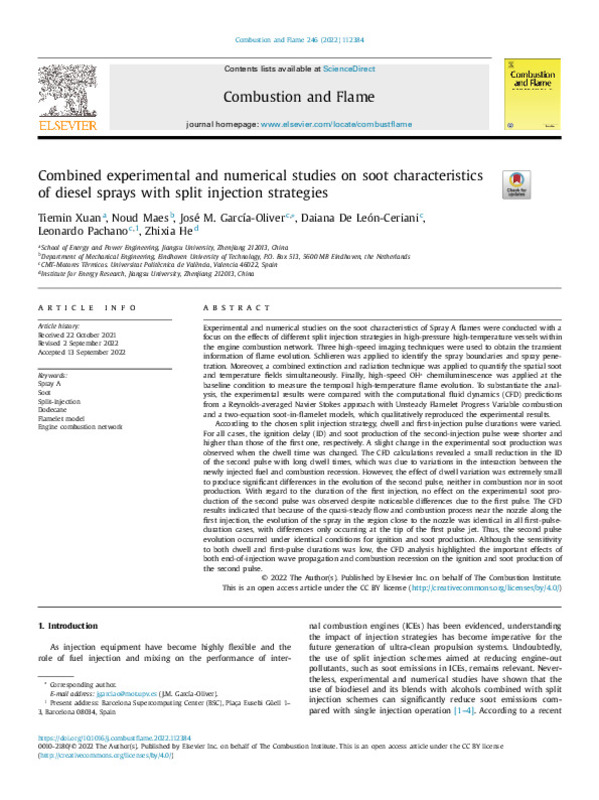JavaScript is disabled for your browser. Some features of this site may not work without it.
Buscar en RiuNet
Listar
Mi cuenta
Estadísticas
Ayuda RiuNet
Admin. UPV
Combined experimental and numerical studies on soot characteristics of diesel sprays with split injection strategies
Mostrar el registro sencillo del ítem
Ficheros en el ítem
| dc.contributor.author | Xuan, Tiemin
|
es_ES |
| dc.contributor.author | Maes, Noud
|
es_ES |
| dc.contributor.author | García-Oliver, José M
|
es_ES |
| dc.contributor.author | De Leon-Ceriani, Daiana
|
es_ES |
| dc.contributor.author | Pachano-Prieto, Leonardo Manuel
|
es_ES |
| dc.contributor.author | He, Zhixia
|
es_ES |
| dc.date.accessioned | 2023-07-03T18:01:22Z | |
| dc.date.available | 2023-07-03T18:01:22Z | |
| dc.date.issued | 2022-12 | es_ES |
| dc.identifier.issn | 0010-2180 | es_ES |
| dc.identifier.uri | http://hdl.handle.net/10251/194639 | |
| dc.description.abstract | [EN] Experimental and numerical studies on the soot characteristics of Spray A flames were conducted with a focus on the effects of different split injection strategies in high-pressure high-temperature vessels within the engine combustion network. Three high-speed imaging techniques were used to obtain the transient information of flame evolution. Schlieren was applied to identify the spray boundaries and spray penetration. Moreover, a combined extinction and radiation technique was applied to quantify the spatial soot and temperature fields simultaneously. Finally, high-speed OH * chemiluminescence was applied at the baseline condition to measure the temporal high-temperature flame evolution. To substantiate the analysis, the experimental results were compared with the computational fluid dynamics (CFD) predictions from a Reynolds-averaged Navier Stokes approach with Unsteady Flamelet Progress Variable combustion and a two-equation soot-in-flamelet models, which qualitatively reproduced the experimental results.According to the chosen split injection strategy, dwell and first-injection pulse durations were varied. For all cases, the ignition delay (ID) and soot production of the second-injection pulse were shorter and higher than those of the first one, respectively. A slight change in the experimental soot production was observed when the dwell time was changed. The CFD calculations revealed a small reduction in the ID of the second pulse with long dwell times, which was due to variations in the interaction between the newly injected fuel and combustion recession. However, the effect of dwell variation was extremely small to produce significant differences in the evolution of the second pulse, neither in combustion nor in soot production. With regard to the duration of the first injection, no effect on the experimental soot production of the second pulse was observed despite noticeable differences due to the first pulse. The CFD results indicated that because of the quasi-steady flow and combustion process near the nozzle along the first injection, the evolution of the spray in the region close to the nozzle was identical in all first-pulseduration cases, with differences only occurring at the tip of the first pulse jet. Thus, the second pulse evolution occurred under identical conditions for ignition and soot production. Although the sensitivity to both dwell and first-pulse durations was low, the CFD analysis highlighted the important effects of both end-of-injection wave propagation and combustion recession on the ignition and soot production of the second pulse. | es_ES |
| dc.description.sponsorship | This research work has been partially supported by the National Natural Science Foundation of China (51906087) and the Natural Science Foundation of Jiangsu Province (BK20190856) . | es_ES |
| dc.language | Inglés | es_ES |
| dc.publisher | Elsevier | es_ES |
| dc.relation.ispartof | Combustion and Flame | es_ES |
| dc.rights | Reconocimiento (by) | es_ES |
| dc.subject | Spray A | es_ES |
| dc.subject | Soot | es_ES |
| dc.subject | Split -injection | es_ES |
| dc.subject | Dodecane | es_ES |
| dc.subject | Flamelet model | es_ES |
| dc.subject | Engine combustion network | es_ES |
| dc.subject.classification | MAQUINAS Y MOTORES TERMICOS | es_ES |
| dc.title | Combined experimental and numerical studies on soot characteristics of diesel sprays with split injection strategies | es_ES |
| dc.type | Artículo | es_ES |
| dc.identifier.doi | 10.1016/j.combustflame.2022.112384 | es_ES |
| dc.relation.projectID | info:eu-repo/grantAgreement/NSFC//51906087/ | es_ES |
| dc.relation.projectID | info:eu-repo/grantAgreement/Natural Science Foundation of Jiangsu Province//BK20190856/ | es_ES |
| dc.rights.accessRights | Abierto | es_ES |
| dc.contributor.affiliation | Universitat Politècnica de València. Escuela Técnica Superior de Ingeniería del Diseño - Escola Tècnica Superior d'Enginyeria del Disseny | es_ES |
| dc.description.bibliographicCitation | Xuan, T.; Maes, N.; García-Oliver, JM.; De Leon-Ceriani, D.; Pachano-Prieto, LM.; He, Z. (2022). Combined experimental and numerical studies on soot characteristics of diesel sprays with split injection strategies. Combustion and Flame. 246:1-17. https://doi.org/10.1016/j.combustflame.2022.112384 | es_ES |
| dc.description.accrualMethod | S | es_ES |
| dc.relation.publisherversion | https://doi.org/10.1016/j.combustflame.2022.112384 | es_ES |
| dc.description.upvformatpinicio | 1 | es_ES |
| dc.description.upvformatpfin | 17 | es_ES |
| dc.type.version | info:eu-repo/semantics/publishedVersion | es_ES |
| dc.description.volume | 246 | es_ES |
| dc.relation.pasarela | S\488636 | es_ES |
| dc.contributor.funder | National Natural Science Foundation of China | es_ES |
| dc.contributor.funder | Natural Science Foundation of Jiangsu Province | es_ES |
| dc.contributor.funder | Universitat Politècnica de València | es_ES |
| dc.subject.ods | 07.- Asegurar el acceso a energías asequibles, fiables, sostenibles y modernas para todos | es_ES |








